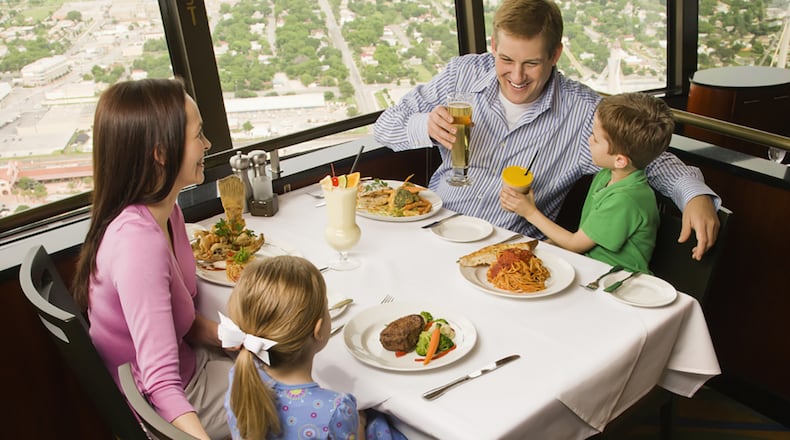- Bread recalled in 11 states due to possible broken glass
- Heartbreaking: Rescue group discovers neglected horses with 3-foot-long hooves
- Reports: Man who reportedly shot, killed WDBJ news crew live on TV dies
- Keyless ignition vehicles targeted in class action lawsuit
- Family claims father robbed bank to pay for daughter's cancer treatment
You have kids. Dining life as you know it is over. It's now all french fries and dinosaur-shaped chicken nuggets. Will you ever again grace the inside of a sleekly designed eatery or a trendy upstart? Sooner than you think! Teaching your children to dine out is as important as teaching them to share. Here's a simple age-by-age guide to dining out with kids.
Baby months
Think of these months as preseason training. Babies are sensitive to light and noise. Exposing them to slightly overstimulating situations eventually will have the reverse effect, which leads to fewer meltdowns as they become desensitized.
- Dine at smaller neighborhood cafes or restaurants where you are regulars.
- Relax with one glass of wine or beer. Kids smell fear, so stay one step ahead.
- Dine earlier and off-peak. Say goodbye to Friday and Saturday evenings for now and eat an early lunch or dinner on a Monday or Tuesday.
- Dine on your child's schedule. Avoid heading out during nap or feeding times.
- As your child turns 1, help him feel relaxed sitting for longer periods with activities like quiet toys or books. Don't dine for longer than an hour.
- Talk to your child. With the ability to sit up on their own and babble, engage them in your dining experience while teaching them simple table manners. Bring snacks for them to nibble on while you eat your meal.
Terrible toddlers
Ages 2-4 may be the most difficult time to dine with children. They are eating on their own, have little personalities, are perfecting the use of the word "No" while throwing themselves on the floor. But for all the frustration this age brings, it's the perfect time to set their taste buds up for success. Expose, expose, expose. These are the sponge years, where tiny humans are soaking up everything around them.
- Take your tot to less familiar restaurants; possibly without a kids menu or booster seats. You can always bring a seat with you. There's no reason eating at a trendy restaurant with a diverse menu is out of the question.
- Dine early and off-peak.
- Keep the meal under an hour by avoiding slower service or ultra busy restaurants.
- Practice manners and sitting. Remember to bring those quiet activities. Running around is not acceptable in a restaurant.
- Don't overwhelm those teeny taste buds. Order a dish similar to what your child eats at home, then slip in a couple of items from your own plate for them to try.
- Teach course pacing. Ask your server to bring out your child's meal at the same time as your own. Order a shared appetizer while you wait.
School days
Your baby is riding the bus, on the soccer team and doing homework. You're parents of a full-time student. You're also parents of a dining expert in the making. While your child may not be a fan of foie gras, having exposed her to a variety of foods, she has developed likes and dislikes. But she's also willing to take risks in her choice of sustenance.
- Teach your petite gourmand how to order his food. Help your child to choose a starter for the table as well as a main course. Then, encourage your child to politely order. This may take practice, but once he does it and sees how proud you are, you'll never order another meal for him again.
- Peak dining days and hours are beginning to return to the rotation but make reservations to avoid long waits. Remember to bring quiet activities.
- Children at this age are super active. Why not take her on a restaurant adventure in an undiscovered part of town.
Tweens 'n teens
You've spent the past few years teaching your child to be a savvy supper. She's now a culinary risk-taker with carefully crafted skills. Feasting as a family at swanky joints is a breeze, because you no longer worry about being THAT table. But there is one more lesson your child must learn before setting her loose on the dining world. The check.
- After the meal, don't be afraid to show your child the cost breakdown for each item. Let her figure out how much the meal was per person.
- Task her with calculating the tip for the server. Twenty percent is customary for good service.
- Help your child understand the server's need for a tip and why it is important to leave one.
Starting the process early and eating out as often as you can afford helps your child develop a life skill instead of the much-feared, public Clash of the Titans battle of wills. You want to raise a savvy diner. It will be a practice in patience, trial and error and sometimes embarrassing moments —but you've got this.
About the Author
Keep Reading
The Latest
Featured



